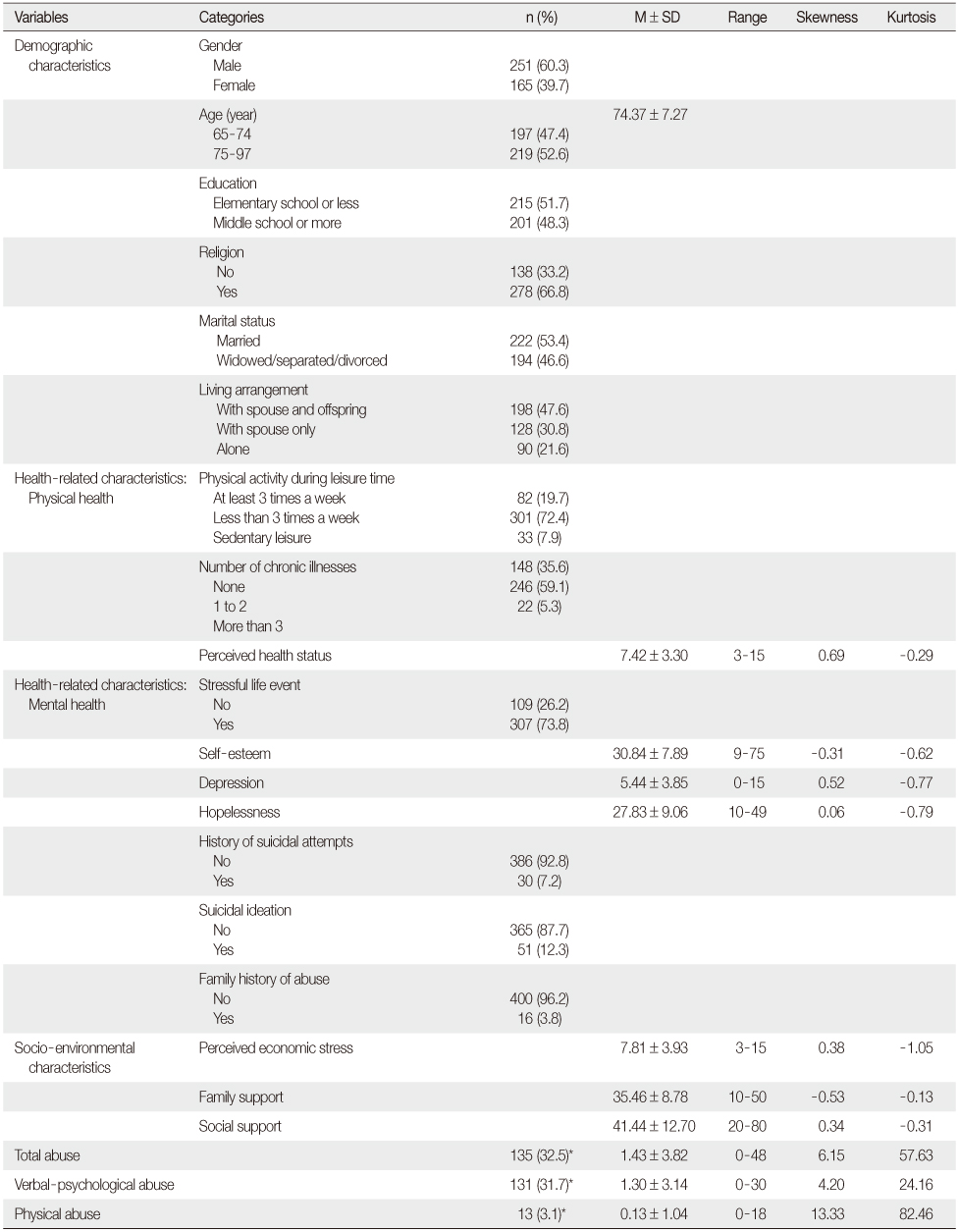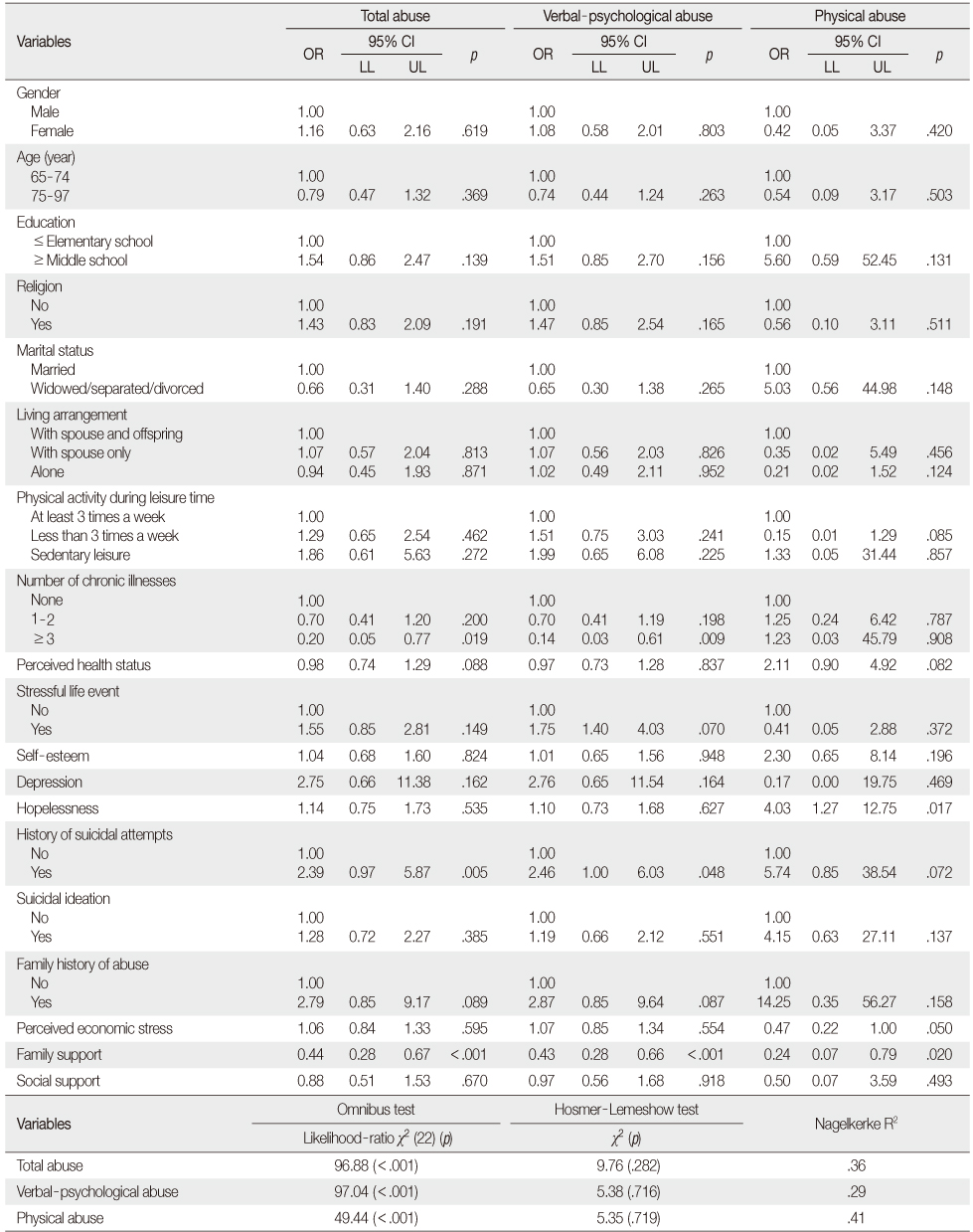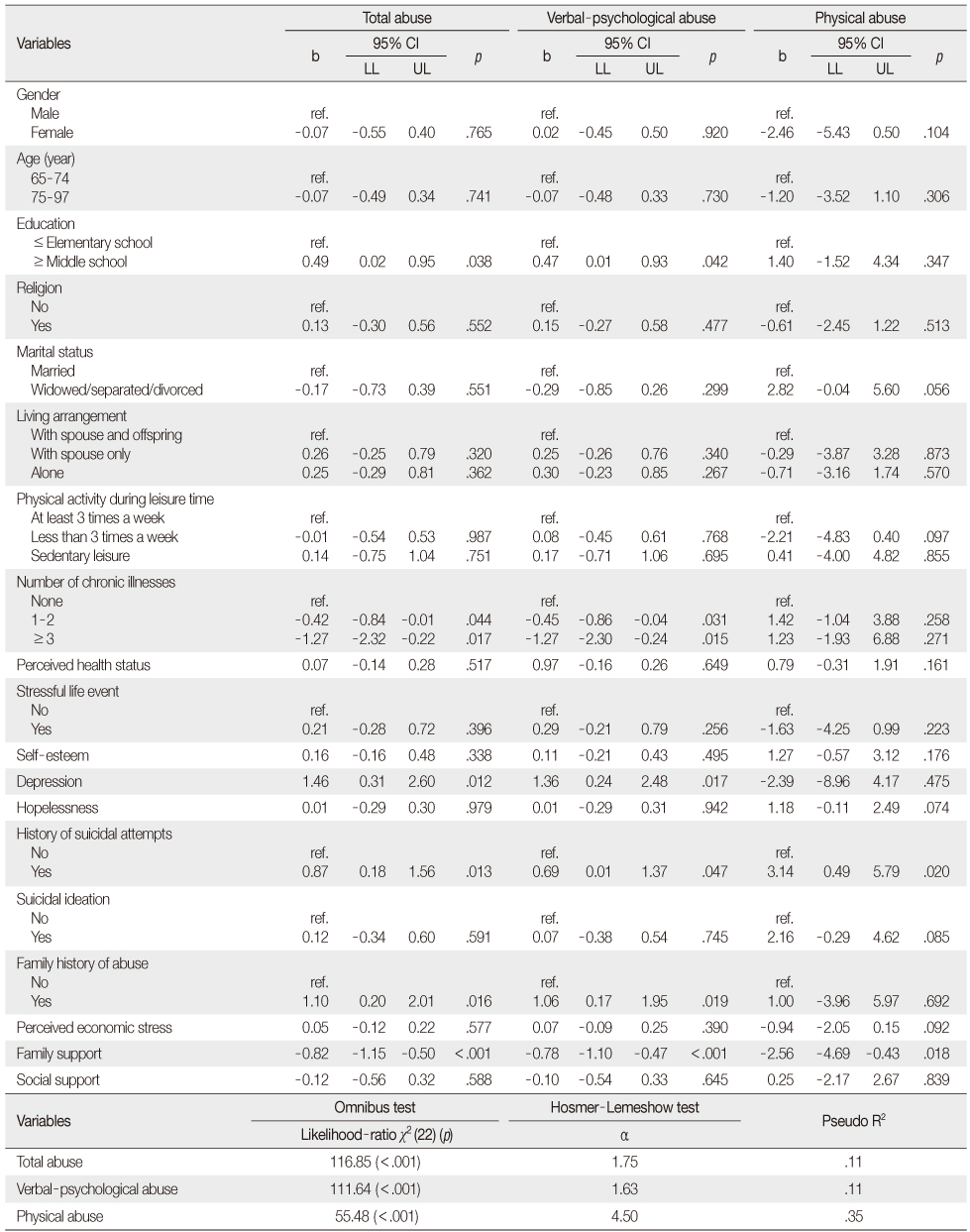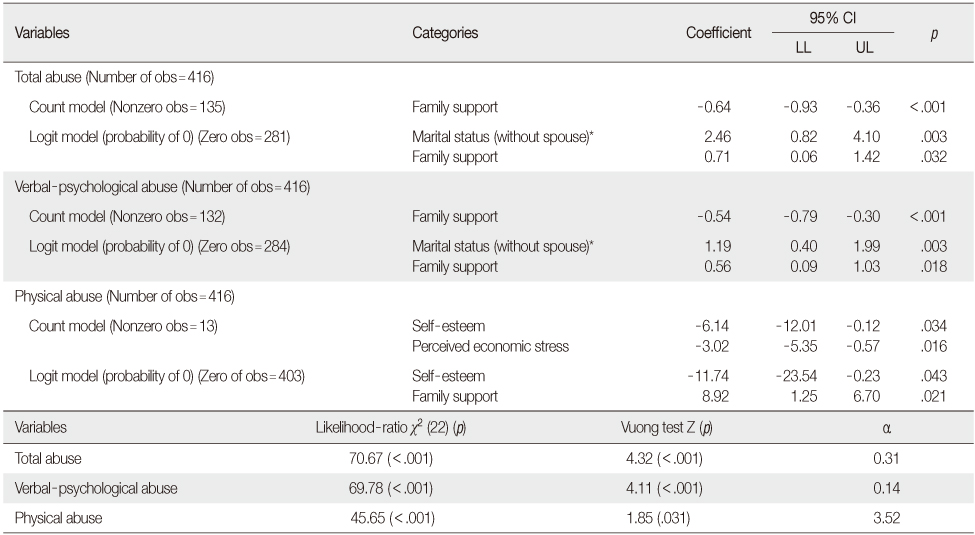Articles
- Page Path
- HOME > J Korean Acad Nurs > Volume 42(6); 2012 > Article
-
Original Article
- Risk Factors Influencing Probability and Severity of Elder Abuse in Community-dwelling Older Adults: Applying Zero-inflated Negative Binomial Modeling of Abuse Count Data
- Mi Heui Jang, Chang Gi Park
-
Journal of Korean Academy of Nursing 2012;42(6):819-832.
DOI: https://doi.org/10.4040/jkan.2012.42.6.819
Published online: December 31, 2012
1College of Nursing Science and East-West Nursing Research Institute, Kyung Hee University, Seoul, Korea.
2College of Nursing, University of Illinois at Chicago, Chicago, USA.
- Address reprint requests to: Jang, Mi Heui. College of Nursing Science and East-West Nursing Research Institute, Kyung Hee University, #1, Hoegi-dong, Dongdaemun-gu, Seoul 130-701, Korea. Tel: +82-2-961-0795, Fax: +82-2-961-9398, mhjang21@gmail.com
© 2012 Korean Society of Nursing Science
- 753 Views
- 5 Download
- 12 Crossref
Abstract
-
Purpose
- This study was conducted to identify risk factors that influence the probability and severity of elder abuse in community-dwelling older adults.
-
Methods
- This study was a cross-sectional descriptive study. Self-report questionnaires were used to collect data from community-dwelling Koreans, 65 and older (N=416). Logistic regression, negative binomial regression and zero-inflated negative binomial regression model for abuse count data were utilized to determine risk factors for elder abuse.
-
Results
- The rate of older adults who experienced any one category of abuse was 32.5%. By zero-inflated negative binomial regression analysis, the experience of verbal-psychological abuse was associated with marital status and family support, while the experience of physical abuse was associated with self-esteem, perceived economic stress and family support. Family support was found to be a salient risk factor of probability of abuse in both verbal-psychological and physical abuse. Self-esteem was found to be a salient risk factor of probability and severity of abuse in physical abuse alone.
-
Conclusion
- The findings suggest that tailored prevention and intervention considering both types of elder abuse and target populations might be beneficial for preventative efficiency of elder abuse.
- 1. Azagba S, Sharaf MF. Psychosocial working conditions and the utilization of health care services. BMC Public Health. 2011;11:642. http://dx.doi.org/10.1186/1471-2458-11-642.PubMedPMC
- 2. Bae JY. Structural equational modeling for elderly suicidal thought. Soc Sci Rev. 2005;23:343–375.
- 3. Baker MW, Heitkemper MM. The roles of nurses on interprofessional teams to combat elder mistreatment. Nurs Outlook. 2005;53:253–259. http://dx.doi.org/10.1016/j.outlook.2005.04.001.ArticlePubMed
- 4. Cooper C, Selwood A, Livingston G. The prevalence of elder abuse and neglect: A systematic review. Age Ageing. 2008;37:151–160. http://dx.doi.org/10.1093/ageing/afm194.ArticlePubMed
- 5. Daly JM. Evidence-based practice guideline: Elder abuse prevention. J Gerontol Nurs. 2011;37(11):11–17. http://dx.doi. org/10.3928/00989134-20111004-01.Article
- 6. Dong XQ, Simon MA, Beck TT, Farran C, McCann J, de Leon CFM, et al. Elder abuse and mortality: The role of psychological and social wellbeing. Gerontology. 2011;57:549–558. http://dx.doi.org/10.1159/000321881.ArticlePubMedPDF
- 7. Jackson SL, Hafemeister TL. Risk factors associated with elder abuse: The importance of differentiating by type of elder maltreatment. Violence Vict. 2011;26:738–757. http://dx.doi.org/10.1891/0886-6708.26.6.738.ArticlePubMed
- 8. Jang TY, Jang TS. Marginal effect of causal elements on traffic accidents. J Korean Reg Dev Assoc. 2004;16:75–87.
- 9. Jon BJ. Self-esteem: A test of its measurability. Yonsei Nonchong. 1974;1:107–130.
- 10. Kee BS. A preliminary study for the standardization of geriatric depression scale short form-Korea version. J Korean Neuropsychiatr Assoc. 1996;35:298–307.
- 11. Khan A, Ullah S, Nitz J. Statistical modelling of falls count data with excess zeros. Inj Prev. 2011;17:266–270. http://dx.doi.org/10.1136/ip.2011.031740.ArticlePubMed
- 12. Kim HJ. A study on the assessment of the risk factors of elderly abuse. J Welf Aged. 2007;37:67–87.
- 13. Kim JY, Kim K. A study on predictors of the elder abuse: Focused on the elderly characteristics and family environments. Korean Criminol Rev. 2007;18:1341–1360.
- 14. Kim S, Park IS. Elder abuse. J Korean Geriatr Psychiatry . 2010;14:3–8.
- 15. Ko CM. A study of nurses' characteristics and their perception of seriousness of elder abuse. J Korean Acad Fundam Nurs. 2010;17:109–118.
- 16. Korea Elder Protection Agency. The report of current state on elder-abuse. 2010;Retrieved April 4, 2012. from http://www.noinboho.or.kr/board2/bbs/board.php?bo_table=news&wr_id=5.
- 17. Luo Y, Waite LJ. Mistreatment and psychological well-being among older adults: Exploring the role of psychosocial resources and deficits. J Gerontol B Psychol Sci Soc Sci. 2011;66:217–229. http://dx.doi.org/10.1093/geronb/gbq096.PubMed
- 18. Ministry of Health and Welfare. The report of national survey on elder abuse. 2010;Retrieved April 4, 2012. from http://www.mw.go.kr/front/al/sal0301vw.jsp?PAR_MENU_ID=04&MENU_ID=0403&BOARD_ID=140&BOARD_FLAG=00&CONT_SEQ=237769&page=1.
- 19. Morrison-Beedy D, Carey MP, Feng CY, Tu XM. Predicting sexual risk behaviors among adolescent and young women using a prospective diary method. Res Nurs Health. 2008;31:329–340. http://dx.doi.org/10.1002/nur.20263.ArticlePubMedPMC
- 20. Oh J, Kim HS, Martins D, Kim H. A study of elder abuse in Korea. Int J Nurs Stud. 2006;43:203–214. http://dx.doi.org/10.1016/j.ijnurstu.2005.03.005.ArticlePubMed
- 21. Schiamberg LB, Gans D. An ecological framework for contextual risk factors in elder abuse by adult children. J Elder Abuse Negl. 1999;11:79–103. http://dx.doi.org/10.1300/J084v11n01_05.Article
- 22. Schmeidel AN, Daly JM, Rosenbaum ME, Schmuch GA, Jogerst GJ. Health care professionals' perspectives on barriers to elder abuse detection and reporting in primary care settings. J Elder Abuse Negl. 2012;24:17–36. http://dx.doi.org/10.1080/08946566.2011.608044.ArticlePubMedPMC
- 23. Shin DS. A study on the correlation among family support, depression and physical health status in elderly. 1996;Seoul, Kyung Hee University. Unpublished master's thesis.
- 24. So H, Kim H, Jung M. A study about elder abuse experience of elderly people. Korean J Rehabil Nurs. 2009;12:120–129.
- 25. Sohn E. A study on how the experience of old females affects their mental health. 2002;Seoul, Yonsei University. Unpublished master's thesis.
- 26. Song MS. Construct of a functional status prediction model for the elderly. 1991;Seoul, Seoul National University. Unpublished doctoral dissertation.
- 27. Song MS. Elderly abuse in domestic settings: Nursing perspective. Korean J Nurs Query. 2007;16:78–101.
- 28. World Health Organization. A global response to elder abuse and neglect: Building primary heath care capacity to deal with the problem world wide: Main report. 2002;Retrieved April 7, 2012. from http://www.who.int/ageing/projects/elder_abuse/en/index.html.
- 29. Yang KM. A study of elder abuse in the domestic setting: Coping strategies and the consequences of elder abuse. J Korean Acad Nurs. 2004;34:1047–1056.ArticlePDF
- 30. Zaninotto P, Falaschetti E. Comparison of methods for modelling a count outcome with excess zeros: Application to activities of daily living (ADL-s). J Epidemiol Community Health. 2011;65:205–210. http://dx.doi.org/10.1136/jech.2008.079640.ArticlePubMed
REFERENCES
Figure & Data
REFERENCES
Citations

- Factors Influencing Probability and Increase of Patients’ Call Bell Use in Integrated Nursing Care Wards
Jiyeong Seong, Sung-Hyun Cho
Journal of Korean Academy of Nursing Administration.2022; 28(3): 273. CrossRef - Blood Pressure Awareness and Knowledge of Cardio-Cerebrovascular Diseases in South Korean Women with Hypertension
Yeo Won Jeong
Healthcare.2021; 9(3): 360. CrossRef - Factors Affecting Scaling Experiences of Adolescent Children from Multicultural and Native Families
Eunsuk Ahn, Jin-Young Yang, Ki-Eun Kim
Journal of Dental Hygiene Science.2020; 20(2): 89. CrossRef - Predictors of Blood and Body Fluid Exposure and Mediating Effects of Infection Prevention Behavior in Shift-Working Nurses: Application of Analysis Method for Zero-Inflated Count Data
Jae Geum Ryu, Smi Choi-Kwon
Journal of Korean Academy of Nursing.2020; 50(5): 658. CrossRef - The Relationship between Smartphone Use and Oral Health in Adolescents
Eunsuk Ahn, Ji-Hyoung Han
Journal of Dental Hygiene Science.2020; 20(1): 44. CrossRef - Fatores associados à violência contra o idoso: uma revisão sistemática da literatura
Maria Angélica Bezerra dos Santos, Rafael da Silveira Moreira, Patrícia Fernanda Faccio, Gabriela Carneiro Gomes, Vanessa de Lima Silva
Ciência & Saúde Coletiva.2020; 25(6): 2153. CrossRef - The Influence of the mother's nationality on adolescent's subjective oral health status-using propensity score matching
Sun Mi Lee, Yun Sin Song, Young Nam Kim, Eunsuk Ahn
Journal of Korean Academy of Oral Health.2018; 42(2): 46. CrossRef - Functional Decline and Emotional Elder Abuse: a Population-Based Study of Older Korean Adults
Jooyoung Kong, Haesang Jeon
Journal of Family Violence.2018; 33(1): 17. CrossRef - Mediating Effects of Burnout on the Relationship between CCTV Perception and Abusive Behavior of Care Workers in Nursing Homes for the Elderly
전병주
치안정책연구.2017; 31(2): 101. CrossRef - Risk factors of severity of abuse against older women in the home setting: A multinational European study
Liesbeth De Donder, Gert Lang, José Ferreira-Alves, Bridget Penhale, Ilona Tamutiene, Minna-Liisa Luoma
Journal of Women & Aging.2016; 28(6): 540. CrossRef - Research on the Influence of Arts and Culture Education in Childhood and Teenage Years on the Consumption of Arts and Culture: Focus on the Zero-inflated Negative Binomial Model
정지은
Journal of Product Research.2016; 34(2): 67. CrossRef - Neighborhood Environment Associated with Physical Activity among Rural Adults: Applying Zero-Inflated Negative Binominal Regression Modeling
Bongjeong Kim
Journal of Korean Public Health Nursing.2015; 29(3): 488. CrossRef
Descriptive Statistics of Study Variables (N=416)
*Elders who experienced abuse at least once within the previous year.
Adjusted Odds Ratio of Risk Factors for Elder Abuse (N=416)
OR=Odds ratio; CI=Confidence interval; LL=Lower limits; UL=Upper limits.
Negative Binomial Regression for the Number of Elder Abuse (N=416)
CI=Confidence interval; LL=Lower limits; UL=Upper limits; ref.=reference category of dummy variable.
Zero-inflated Negative Binominal Regression for the Number of Elder Abuse
CI=Confidence interval; LL=Lower limits; UL=Upper limits; obs=observations.
*Dummy variables: marital status=married (with spouse) vs. widowed/separated/divorced (without spouse).
*Elders who experienced abuse at least once within the previous year.
OR=Odds ratio; CI=Confidence interval; LL=Lower limits; UL=Upper limits.
CI=Confidence interval; LL=Lower limits; UL=Upper limits; ref.=reference category of dummy variable.
CI=Confidence interval; LL=Lower limits; UL=Upper limits; obs=observations. *Dummy variables: marital status=married (with spouse) vs. widowed/separated/divorced (without spouse).
 KSNS
KSNS
 E-SUBMISSION
E-SUBMISSION




 Cite
Cite

